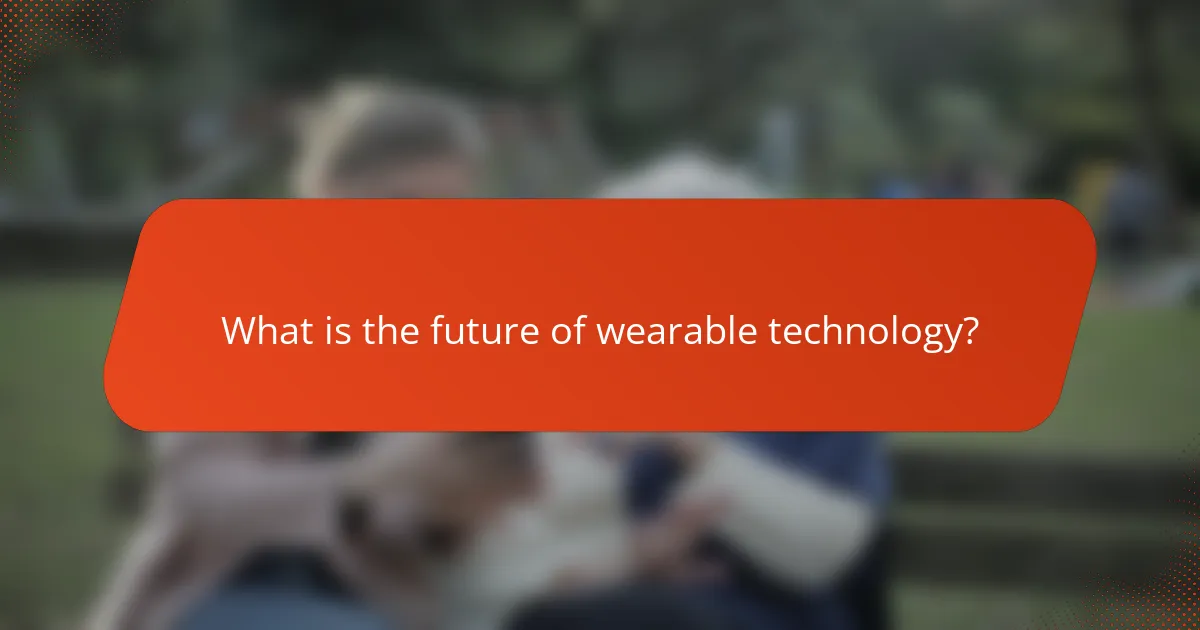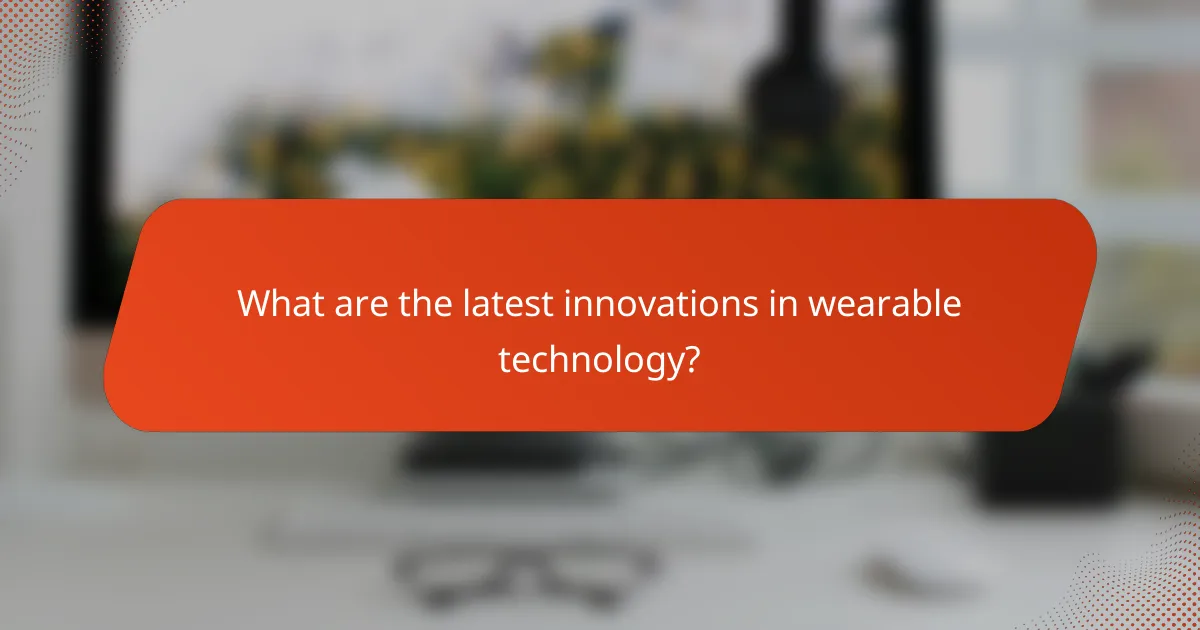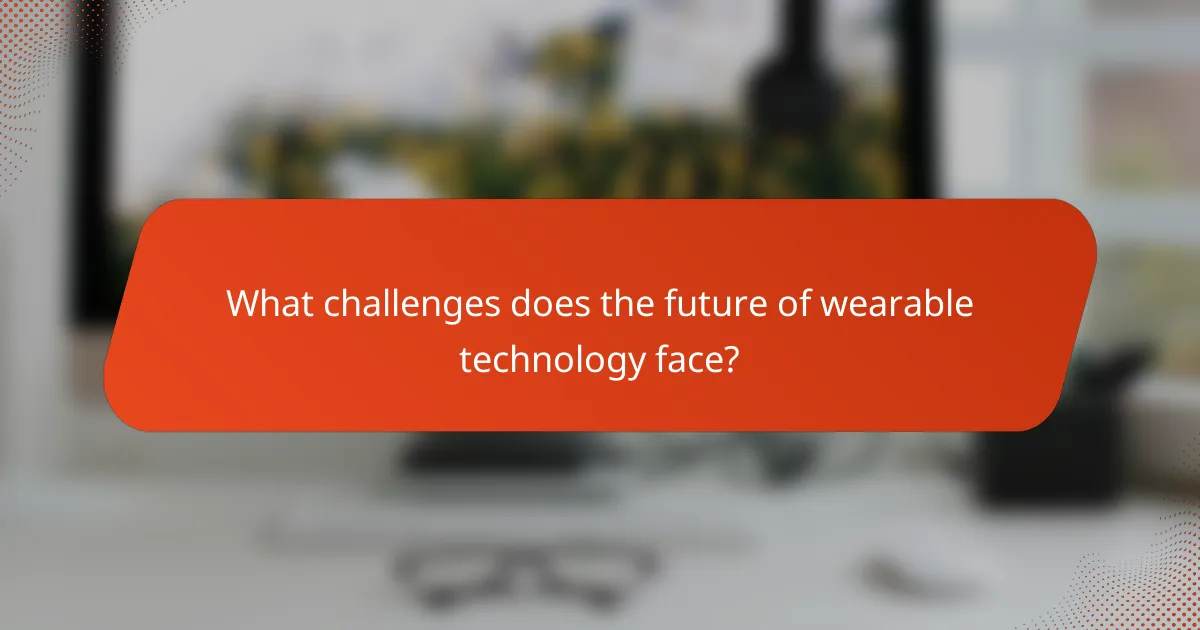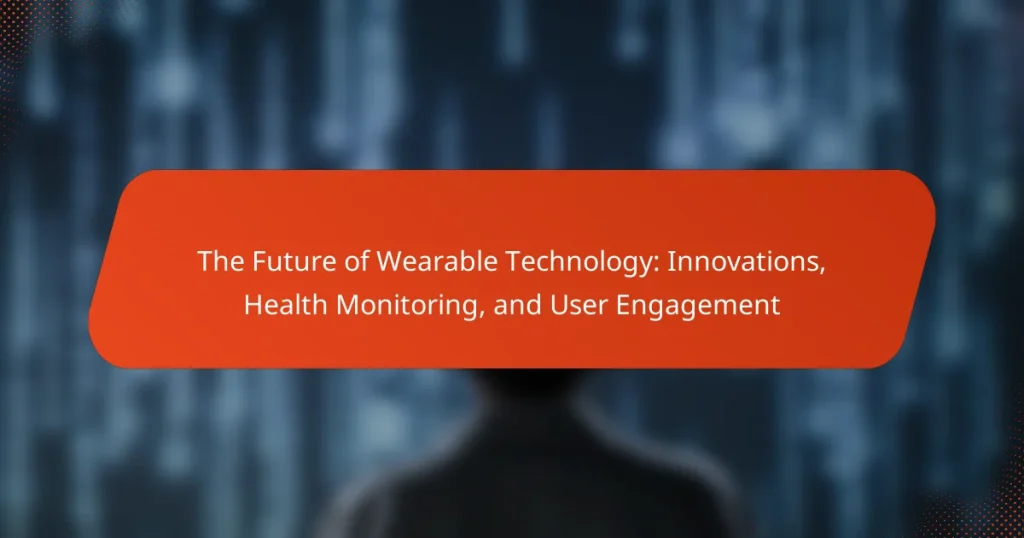Wearable technology encompasses devices designed to monitor health and enhance user engagement through innovative features. The article highlights advancements such as real-time health data tracking, integration of artificial intelligence for personalized insights, and improved battery life and connectivity. The global wearable technology market is projected to reach $60 billion by 2023, driven by consumer demand for health-focused solutions. However, challenges such as data privacy, battery efficiency, user engagement, compatibility with existing technology, regulatory compliance, and cost must be addressed to ensure the successful development of these devices. The future of wearables promises to be more sophisticated, user-friendly, and health-oriented, with potential expansions into areas like augmented reality and smart clothing.

What is the Future of Wearable Technology?
The future of wearable technology is expected to focus on enhanced health monitoring and user engagement. Innovations will likely include advanced sensors for real-time health data tracking. Future wearables may integrate artificial intelligence for personalized health insights. Improved battery life and connectivity will enhance user experience. The global wearable technology market is projected to reach $60 billion by 2023, indicating significant growth. User engagement will increase through gamification and social features. Wearables will also likely expand into new applications, such as augmented reality and smart clothing. Overall, the future promises more sophisticated, user-friendly, and health-oriented devices.
How is wearable technology evolving in recent years?
Wearable technology is evolving rapidly with advancements in health monitoring, connectivity, and user engagement. Recent innovations include smartwatches that track heart rate, sleep patterns, and physical activity. These devices now offer features like ECG monitoring and blood oxygen level tracking. Enhanced connectivity through 5G networks allows for real-time data sharing and improved functionality. User engagement has increased with personalized health insights and gamified fitness challenges. The global wearable technology market is projected to grow significantly, reaching over $60 billion by 2023. This growth reflects consumer demand for health-focused and connected devices.
What are the key innovations driving this evolution?
Key innovations driving the evolution of wearable technology include advanced sensors, artificial intelligence, and improved connectivity. Advanced sensors enable more accurate health monitoring, such as heart rate and blood oxygen levels. Artificial intelligence enhances data analysis, providing personalized health insights. Improved connectivity, including 5G technology, allows for real-time data transmission and seamless integration with other devices. These innovations contribute to enhanced user engagement and better health outcomes. According to a report by Grand View Research, the wearable technology market is expected to reach $87 billion by 2026, driven by these advancements.
How do consumer demands influence wearable technology advancements?
Consumer demands significantly influence wearable technology advancements. Companies prioritize features that consumers desire, such as improved health tracking and longer battery life. For instance, a survey by Statista revealed that 45% of consumers want wearables with advanced health monitoring capabilities. This demand drives manufacturers to innovate in sensors and algorithms. Additionally, aesthetics and style are vital, as 30% of users consider design before purchasing. The need for compatibility with other devices also shapes advancements, pushing brands to enhance interoperability. Overall, consumer feedback directly impacts the research and development focus in the wearable tech industry.
What role does health monitoring play in wearable technology?
Health monitoring is a fundamental aspect of wearable technology. It enables users to track vital signs and physical activity in real-time. Devices like smartwatches and fitness trackers collect data on heart rate, sleep patterns, and exercise levels. This information helps individuals make informed health decisions. Studies show that users who monitor their health tend to engage more in physical activities. Furthermore, health monitoring can alert users to potential health issues early. This proactive approach can lead to better health outcomes. According to a 2021 study published in the Journal of Medical Internet Research, wearable health technology significantly improves user engagement in personal health management.
How do wearables track health metrics?
Wearables track health metrics through sensors that monitor physiological data. These sensors can measure heart rate, steps, sleep patterns, and body temperature. Data is collected continuously or at set intervals. The information is then processed and analyzed using algorithms. This analysis provides insights into the user’s health status. Many wearables sync data with mobile applications for easy access. Research shows that wearables can improve health awareness and encourage healthier behaviors. A study published in the Journal of Medical Internet Research found that users of wearable devices reported increased physical activity levels.
What types of health data can be monitored by wearables?
Wearable devices can monitor various types of health data. Commonly tracked data includes heart rate, which provides insights into cardiovascular health. Wearables also track physical activity levels, measuring steps taken and calories burned. Sleep patterns are monitored to assess sleep quality and duration. Some devices measure blood oxygen levels, which can indicate respiratory health. Wearables can also track stress levels through heart rate variability. Body temperature is another health metric that can be monitored. These capabilities enhance personal health management and inform users about their well-being.
How does user engagement impact the adoption of wearable technology?
User engagement significantly impacts the adoption of wearable technology. High levels of user engagement lead to increased familiarity and comfort with devices. Engaged users are more likely to explore features and functionalities. This exploration enhances perceived value and utility of the technology. Research shows that 60% of users who actively engage with wearables report improved health outcomes. Additionally, social sharing of experiences can influence others to adopt similar technologies. User engagement creates a positive feedback loop, encouraging further adoption and innovation in wearable tech.
What features enhance user engagement with wearable devices?
Personalization enhances user engagement with wearable devices. Customizable settings allow users to tailor their experience. Features like personalized notifications and health tracking metrics increase relevance. Social connectivity encourages sharing achievements and challenges. Gamification elements, such as rewards and challenges, motivate users to engage regularly. Intuitive user interfaces simplify navigation and enhance usability. Regular software updates introduce new features and improve functionality. According to a study by the Journal of Medical Internet Research, personalized health feedback significantly boosts user interaction with wearable devices.
How do social interactions influence the use of wearables?
Social interactions significantly influence the use of wearables by encouraging user engagement and fostering community. When individuals share their wearable data, it promotes accountability and motivation. Social platforms often integrate with wearable devices, allowing users to compare metrics with friends. This comparison can lead to increased physical activity and adherence to health goals. A study by Pew Research Center found that 30% of wearable users are motivated by social interactions. Additionally, social features in wearables can enhance user experience and satisfaction. Users are more likely to adopt wearables that facilitate social connectivity and competition. Thus, social interactions are a key driver of wearable technology usage.

What are the latest innovations in wearable technology?
Latest innovations in wearable technology include advanced health monitoring features, improved battery life, and enhanced connectivity. Devices now track vital signs like heart rate, blood oxygen levels, and sleep patterns with greater accuracy. New materials are making wearables lighter and more comfortable. Integration with artificial intelligence allows for personalized health insights. Devices like smartwatches now offer ECG monitoring and fall detection. Enhanced waterproofing and durability are also key advancements. These innovations are supported by growing consumer demand for health-focused technology. The global wearable technology market is projected to reach $60 billion by 2023, reflecting rapid growth in this sector.
How are advancements in sensors shaping wearable devices?
Advancements in sensors are significantly enhancing the functionality of wearable devices. These improvements enable more accurate health monitoring, such as heart rate and oxygen saturation tracking. Enhanced sensors can also measure physical activity with greater precision. For instance, accelerometers and gyroscopes provide detailed movement data. This data helps in developing personalized fitness plans. Furthermore, advancements in biosensors allow for real-time monitoring of biochemical markers. This capability can lead to early detection of health issues. As a result, users receive timely insights into their health status. Overall, sensor advancements are crucial in making wearable devices more effective and user-friendly.
What types of sensors are commonly used in wearables?
Common types of sensors used in wearables include accelerometers, gyroscopes, heart rate monitors, and temperature sensors. Accelerometers detect motion and orientation. They help track physical activities like steps and exercise intensity. Gyroscopes measure rotational movement. They enhance navigation and stability tracking. Heart rate monitors measure pulse rates. They provide insights into cardiovascular health during workouts. Temperature sensors monitor body temperature. They can indicate health changes or exercise intensity. These sensors are crucial for health monitoring and user engagement in wearable technology.
How do these sensors improve functionality and accuracy?
These sensors improve functionality and accuracy by providing real-time data collection. They utilize advanced algorithms to analyze biometric signals. This enhances measurement precision in health metrics like heart rate and oxygen levels. For example, optical sensors can detect blood flow changes with high accuracy. Additionally, accelerometers track movement patterns effectively. This data allows for personalized health insights and alerts. Studies show that improved sensor technology can reduce error margins by up to 30%. Overall, these advancements lead to more reliable health monitoring in wearable devices.
What are the emerging trends in wearable technology design?
Emerging trends in wearable technology design include increased integration of health monitoring features. Wearables now often track vital signs like heart rate, sleep patterns, and physical activity. Another trend is the incorporation of artificial intelligence for personalized user experiences. AI can analyze user data to provide tailored recommendations. Additionally, there is a shift towards more stylish and customizable designs. This approach aims to enhance user engagement and acceptance. Sustainability is also gaining attention, with manufacturers focusing on eco-friendly materials. Furthermore, wearables are becoming more interconnected, utilizing IoT for seamless data sharing. These trends reflect a growing emphasis on user-centric design and functionality in wearable technology.
How is fashion influencing the design of wearable devices?
Fashion significantly influences the design of wearable devices by prioritizing aesthetics alongside functionality. Designers integrate trendy elements, colors, and materials to appeal to consumers’ fashion sensibilities. This shift encourages brands to collaborate with fashion designers for unique, stylish products. For instance, smartwatches now feature interchangeable bands that match various outfits. Research indicates that 60% of consumers prefer wearables that look good over those that prioritize technical features. Additionally, fashion-forward designs enhance user acceptance and increase the likelihood of regular usage. As a result, the wearable technology market is evolving to blend high-tech functionality with contemporary style.
What role does user interface design play in wearable technology?
User interface design is crucial in wearable technology. It determines how users interact with devices. A well-designed interface enhances user experience and engagement. It simplifies navigation and access to features. Effective UI design also improves functionality and usability. Research indicates that intuitive interfaces increase user satisfaction. For instance, studies show that 70% of users prefer devices with clear, simple interfaces. This highlights the importance of user interface design in wearable technology.
How is artificial intelligence integrated into wearable technology?
Artificial intelligence is integrated into wearable technology through data analysis and predictive algorithms. Wearable devices collect vast amounts of health and activity data. AI processes this data to identify patterns and provide insights. For example, smartwatches monitor heart rate and sleep patterns. AI algorithms can detect anomalies in this data. This enables early detection of potential health issues. Furthermore, AI enhances user engagement with personalized recommendations. Devices can suggest workouts or lifestyle changes based on individual performance. This integration improves user experience and health outcomes.
What benefits does AI provide to wearable devices?
AI enhances wearable devices by enabling advanced health monitoring, personalized user experiences, and efficient data processing. It allows for real-time health tracking, such as heart rate and sleep patterns, which improves user insights. AI algorithms analyze data to provide personalized recommendations for fitness and wellness. This leads to better engagement and adherence to health goals. Additionally, AI enhances battery life by optimizing power consumption based on usage patterns. According to a study by the Journal of Medical Internet Research, AI integration in wearables has shown a 30% increase in user satisfaction. This demonstrates the significant impact of AI on the effectiveness and usability of wearable technology.
How does AI enhance health monitoring capabilities?
AI enhances health monitoring capabilities by providing real-time data analysis and predictive insights. It processes vast amounts of health data from wearable devices. This enables early detection of potential health issues. For instance, AI algorithms can analyze heart rate patterns to identify arrhythmias. Machine learning models improve accuracy over time by learning from new data. AI can also personalize health recommendations based on user behavior and preferences. Research shows that AI-driven tools can reduce hospital readmission rates by up to 30%. These advancements lead to proactive health management and better patient outcomes.

What challenges does the future of wearable technology face?
The future of wearable technology faces several significant challenges. One major challenge is data privacy and security. Wearable devices collect sensitive personal information, raising concerns about unauthorized access. Another challenge is battery life and energy efficiency. Many wearable devices struggle to balance functionality with long-lasting battery performance. Additionally, user engagement remains a critical issue. Many users abandon wearable devices due to a lack of compelling features or perceived value. Compatibility with existing technology ecosystems is also a challenge. Wearables must seamlessly integrate with smartphones and other devices to enhance user experience. Furthermore, regulatory hurdles exist. Compliance with health regulations can complicate the development of health-monitoring wearables. Finally, the high cost of advanced technology can limit accessibility for consumers. These challenges must be addressed to ensure the successful evolution of wearable technology.
How do privacy concerns affect wearable technology adoption?
Privacy concerns significantly hinder the adoption of wearable technology. Many potential users fear that their personal data may be misused or inadequately protected. For instance, a 2021 survey found that 70% of respondents were worried about data breaches in wearable devices. These concerns lead to a lack of trust in the technology. Users are hesitant to share sensitive health information with devices that may not have robust security measures. Additionally, regulatory issues around data privacy further complicate user acceptance. Companies must address these concerns to encourage wider adoption of wearable technology.
What measures can be taken to ensure user data security?
Implementing strong encryption is essential to ensure user data security. Encryption protects data by converting it into a code that can only be deciphered with a key. Regular software updates are crucial as they often contain security patches. These patches address vulnerabilities that could be exploited by attackers.
User authentication measures, such as two-factor authentication, enhance security by requiring additional verification. This adds an extra layer of protection against unauthorized access. Data minimization practices should be adopted to collect only essential information. Reducing the amount of stored data decreases the risk of exposure during a breach.
Secure data storage solutions are necessary to protect user information from unauthorized access. Utilizing cloud services with strong security protocols can safeguard data effectively. Conducting regular security audits helps identify and mitigate potential vulnerabilities. These audits ensure that security measures are up to date and effective.
User education on data security practices is vital. Informing users about phishing attacks and safe online behavior empowers them to protect their information. Compliance with data protection regulations, such as GDPR, is also essential. Adhering to these regulations ensures that user data is handled responsibly and securely.
How do regulations impact the development of wearable devices?
Regulations significantly impact the development of wearable devices by establishing safety and efficacy standards. These regulations ensure that devices meet health and safety requirements before reaching consumers. For example, the FDA in the United States mandates that certain wearable devices undergo rigorous testing. This testing evaluates their performance and potential risks to users. Compliance with regulations can influence design, functionality, and market entry timelines. Companies may need to invest in additional resources to meet these regulatory demands. Moreover, regulations can foster consumer trust by ensuring that products are safe and reliable. Ultimately, regulatory frameworks shape the innovation landscape for wearable technology.
What technical limitations currently exist in wearable technology?
Wearable technology currently faces several technical limitations. Battery life remains a significant challenge, with most devices lasting only one to two days before needing a recharge. Connectivity issues can arise, particularly in environments with poor wireless signals, which affects data transmission. Limited processing power restricts the complexity of applications that can be run on these devices. Additionally, many wearables lack advanced sensors, which limits their ability to collect comprehensive health data. User comfort and design constraints can also hinder prolonged use. Data privacy concerns persist, as users are often unsure of how their information is being used. Finally, interoperability between different devices and platforms can create compatibility issues, complicating user experience.
How can battery life be improved in wearables?
Battery life in wearables can be improved through several strategies. Utilizing low-power components reduces energy consumption. Implementing energy-efficient software algorithms optimizes battery usage. Adaptive brightness settings can extend battery life by adjusting screen brightness based on ambient light. Incorporating energy-saving modes allows wearables to limit functionality during low battery levels. Regular software updates can enhance power management features. Additionally, using advanced battery technologies, such as lithium-polymer batteries, increases energy density. Research indicates that these methods can lead to significant improvements in battery longevity, enhancing user experience in wearable technology.
What are the challenges in achieving accurate health monitoring?
Achieving accurate health monitoring faces several challenges. One major challenge is data accuracy. Inconsistent readings can occur due to device calibration issues. Another challenge is user compliance. Users may not consistently wear devices or follow monitoring protocols. Environmental factors can also affect accuracy. For instance, temperature and humidity can influence sensor performance. Additionally, the diversity of individual physiology poses a challenge. Different users may exhibit varying responses to the same health metrics. Data interpretation is complex as well. Misinterpretation can lead to incorrect health assessments. Lastly, privacy concerns may hinder data sharing. Users may be reluctant to share sensitive health information, impacting the overall effectiveness of health monitoring systems.
What are the best practices for maximizing the benefits of wearable technology?
To maximize the benefits of wearable technology, users should regularly update their devices. Keeping software current enhances functionality and security. Users should also set clear health and fitness goals. Specific targets increase motivation and track progress effectively. Engaging with companion apps provides personalized insights. These insights help in understanding data trends over time. Wearing the device consistently yields more accurate data collection. Continuous usage allows for better monitoring of health metrics. Users should take advantage of community features. Participating in challenges can boost engagement and accountability. Lastly, understanding privacy settings is crucial. This ensures that personal data is protected while using the technology.
How can users effectively integrate wearables into their daily lives?
Users can effectively integrate wearables into their daily lives by establishing clear goals for their use. Setting specific objectives, such as tracking fitness levels or monitoring sleep patterns, enhances motivation. Wearables should be worn consistently to gather accurate data over time. This consistency allows users to observe trends and make informed adjustments to their routines.
Additionally, users can leverage mobile apps that sync with their devices. These apps often provide personalized insights and reminders, which can reinforce healthy habits. Users should also engage with community features within these apps. Sharing progress with friends or joining challenges can boost accountability and motivation.
Regularly reviewing data collected by wearables is crucial. This practice helps users understand their health metrics better and adapt their lifestyle accordingly. Lastly, integrating wearables into daily routines can be simplified by setting reminders for tasks like hydration or activity breaks. This proactive approach ensures that wearables serve as effective tools for enhancing overall well-being.
What tips can enhance the user experience with wearable devices?
To enhance the user experience with wearable devices, users should ensure proper fit and comfort. A well-fitted device improves tracking accuracy and overall usability. Regularly updating the device’s software is also crucial. Updates often include performance improvements and new features. Users should customize notifications to avoid information overload. Tailored notifications help prioritize important alerts. Engaging with companion apps can enhance functionality. These apps often provide deeper insights into health data. Users should explore available features to maximize device potential. Familiarity with all features can lead to better usage. Lastly, maintaining battery health ensures uninterrupted usage. A charged device enhances reliability and user satisfaction.
The main entity of the article is wearable technology, which encompasses devices designed to monitor health and engage users. The article explores the future of wearable technology, highlighting innovations such as advanced sensors, artificial intelligence integration, and enhanced connectivity that improve health monitoring capabilities. It discusses the evolution of wearables, driven by consumer demands for better health tracking and user engagement features. Additionally, the article addresses challenges related to data privacy, battery life, and regulatory compliance that must be overcome for the successful advancement of this technology. Overall, it provides a comprehensive overview of trends, innovations, and the impact of user engagement on the adoption of wearable devices.




